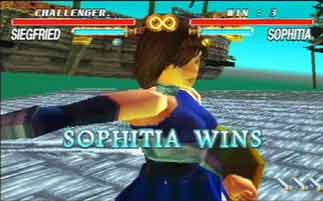

Miltos Manetas, "I AM SORRY", 1997 , DVD
Made with Soul Blade by Namco for Sony Playstation
Selected Exhibitions:
1997: 'Fatto in Italia', Made in Italy, Centre d'Art Contemporain de Geneva, Switzerland, and, ICA, London,
1999: AFTER VIDEOGAMES, Lux Gallery, London
2000: Synopsis 1, National Museum of Contemporary Art, Athens, GR
2001-2004: "My Reality: Contemporary Art and the Culture of Japanese Animation, Brooklyn Museum of Art Brooklyn, NY
Contemporary Arts Center, Cincinnati, OH, Tampa Museum of Art Tampa, FL, Chicago Cultural Center Chicago, IL, Akron Art Museum Akron, OH
Norton Museum of Art, West Palm Beach, FL, Museum of Glass: International Center for Contemporary Art, Tacoma, WA, Huntsville Museum of Art, Huntsville, AL (info)
comments:
Miltos Manetas's videos don't belong in any show. The Greek expat recorded video games, then digitally manipulated them. For the first hour of his 70-minute "I Am Sorry," two characters stand still with their swords drawn, ready to fight. Every few minutes, their shadows rotate and the background sky changes color. Genius. In "Flames I and II," Manetas creates short loops of Tomb Raider, in which Lara Croft visits the same obstacle over and over. The digital age's Sisyphus, perhaps?
By Michael Wells for The Brooklyn Papers
Miltos Manetas is one of the artists who addresses these mixed messages, as in her video piece, "Flames 1."
"A video game, actually," says Kotik. "The heroine is very strong and very beautiful and very young, so I could see it as a tribute to the woman warrior and femininity. But then there is a moment where, even after she wins, she kind of says, 'I am sorry.'"
In the video installation by Miltos Manetas the electronic games of virtual reality become victims of an intertextual game. The artist exploits the open narrative of the interactive game, or the chance occurrence, such as mistakes in the use of the program on the computer, in order to extract probable scenarios and create new fictions employing digital fragments, which he isolates and records on video. The ready narratives- irrational or void of meaning are references to the artistic practices that developed after Duchamp’s ready-mades. Nevertheless, the artist’s interest is focused more on the electronic intertextuality itself, as an open process of communication for the exchange of images, codes, media and systems of representation.